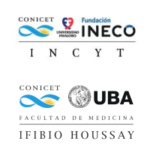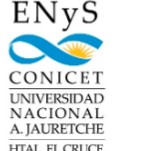
Menu
Oral Communications
Friday 9
Macarena Lorena Herrera
Departamento de Farmacología. Facultad de Ciencias Químicas. Universidad Nacional de Córdoba. Instituto de Farmacología Experimental de Córdoba (IFEC). CONICET
Intramuscular insulin-like growth factor-1 gene therapy modulates reactive microglia after traumatic brain injury
Reactive gliosis is a key feature and an important pathophysiological mechanism underlying chronic neurodegeneration following traumatic brain injury (TBI). In this study, we have explored the effects of intramuscular IGF-1 gene therapy on reactive gliosis and functional outcome after an injury of the cerebral cortex. Young adult male rats were intramuscularly injected with a recombinant adenoviral construct harboring the cDNA of human IGF-1 (RAd-IGF1), with a control vector expressing green fluorescent protein (RAd-GFP) or PBS as control. Three weeks after the intramuscular injections of adenoviral vectors, animals were subjected to a unilateral penetrating brain injury. The data revealed that RAd-IGF1 gene therapy significantly increased serum IGF1 levels and prevent working memory deficits after one week of TBI. At the same time, when we analyzed the effects of therapy on glial scar formation, the treatment with RAd-IGF1 did not modify the number of glial fibrillary acidic protein but we observed a decrease in vimentin immunoreactive astrocytes at 7 days post-lesion in the injured hemisphere, compared to animals treated with RAd-GFP. Moreover, IGF-1 gene therapy reduced the number of Iba1+ cells with reactive phenotype and the number of MHCII+ cells in the injured hemisphere. These results suggest that intramuscular IGF-1 gene therapy may represent a new approach to prevent traumatic brain injury outcomes in rats.

Milagros Trotta
Laboratorio de Neuroendocrinología Molecular, Instituto de Fisiología y Biofísica "Bernardo Houssay" (IFIBIO, UBA-CONICET), Universidad de Buenos Aires-CONICET
Hypothalamic proopiomelanocortin expression restricted to GABAergic neurons prevents overfeeding and Neuropeptide Y overexpression
The arcuate nucleus is a key regulator of energy homeostasis in which different neuronal populations integrate peripheral signals of energy status. In particular, arcuate proopiomelanocortin (POMC) neurons inhibit food intake and promote energy expenditure. Due to the existence of different subpopulations of POMC neurons secreting antagonistic neurotransmitters such as glutamate or GABA, it is proposed that Arc-POMC neurons could have different physiological roles and targets. In the present study, we aimed to elucidate the contribution of the subpopulation of Arc-POMC GABAergic neurons in the control of energy balance by expressing Pomc exclusively in GABAergic-POMC neurons. We found that Pomc rescue restricted to GABAergic neurons leads to food intake normalization and body weight enhancement. Surprisingly, these physiological improvements were achieved with the recovery of Pomc expression in only 25% of total hypothalamic POMC neurons. Immunohistochemical analysis showed that GABAergic POMC neurons preferentially project to the dorsomedial hypothalamus (DMH), a nucleus that induces food intake by releasing NPY. In addition, we found that DMH-NPY expression is negatively correlated with Pomc expression in GABAergic-POMC neurons, suggesting that food intake may be regulated by an Arc-GABAergic-POMC→ DMH-NPY pathway.

Juan Francisco Döppler
Laboratorio de Sistemas Dinámicos, Departamento de Física, Facultad de Ciencias Exactas y Naturales, Universidad de Buenos Aires; IFIBA-CONICET
Motor replays of song during sleep in a suboscine bird
Birdsong production requires a precise control of the respiratory system and muscles in the syrinx, the avian vocal organ. Oscine birds use a set of highly developed neural nuclei which produce precise patterns of activity to achieve this. Interestingly, these patterns have been shown to occur spontaneously during sleep. Even more, while the respiratory pathway is blocked during sleep (and thus birds don’t sleep-sing), the pathway innervating the syrinx is not, and this activity arrives at the muscles, making the periphery a window into the sleeping brain.
In tyrannid suboscine birds (phylogenetically close to oscine birds, usually considered non-learners) such developed neural nuclei haven´t been found, thus making this window a unique tool to study sleep in the non-learning brain.
In this work we study the suboscine Pitangus Sulphuratus. We focus on the obliquus ventralis, a muscle involved in the amplitude modulation of sound during song. We show that events of song-like activity occur during sleep, as in the case of oscine birds. This activity is consistent with the rehearsal of the song, or part of it, and has some variability not observed during wake. We also find a set of qualitatively different events, compatible with another vocalization, usually produced during territorial dispute and accompanied by a behavioral display. Using recordings of the sleeping bird we show that the activity is consistently produced during sleep simultaneously with the behavioral display.
Federico Gascue
Laboratorio de Plasticidad Sensorial/IFIByNE/UBA
Sensory adaptation and the representation of complex odors in the antennal lobe of Apis mellifera.
Sensory systems must be adjusted based on the animal’s experience in order to optimize perception of relevant information and ignore stimuli without predictive value. In this context, one of the main phenomena that modulate the olfactory system is adaptation, which is defined as the decrease of the sensitivity or response to an odor after a sustained exposure to it. Adaptation may occur in brief intervals of time and depends on the immediate experience of the animal. In this project, we use Apis mellifera to study the representation of binary mixtures of odors in the brain after sensory adaptation to one of the components. We performed calcium imaging experiments to measure odor induced signals in the antennal lobe, the first olfactory neuropil in the insect brain. We determined that, after olfactory adaptation, response patterns encoding the mixture are drastically altered, in a way that favors the representation of the non-adapted component. These changes are relatively brief, lasting about a minute. Additionally, by means of behavioral experiments, we show that adaptation reduces appetitive learning of the adapted component, while it enhances learning of the other component in cases in which it would normally stay occluded. These results suggest that olfactory adaptation is critical to allow detection of minor components present in complex mixtures, emphasizing that sensory adaptation is a fundamental mechanism to improve sensitivity to salient and discrete stimuli.
Diego Nicolás Messina
Laboratorio de Neurobiología del Dolor, Instituto de Histología y Embriología de Cuyo (IHEM - CONICET - UNCuyo)
Nav1.8 relation with chronic inflammatory pain and aging
We aimed to determine the expression pattern of Nav1.8 in primary sensory neurons of the DRG in young adult rats (3-6 months) and aged rats (12-18 months), and correlate this pattern with the behavioral changes observed in a model of chronic inflammatory pain. We quantified the expression of Nav1.8 by ABC/DAB immunohistochemistry in serial sections of L4 and L5 DRGs from Wistar rats aged 3, 6, 12 and 18 months. We induced inflammation with an intradermal injection of Complete Freund’s Adjuvant solution (CFA) in 8 3-months-old and 12 14-months-old rats. We evaluated two types of pain during 120 days after CFA: spontaneous pain, using the spontaneous foot lifting test (SFL) and evoked pain, with the von Frey test. Nav1.8 staining intensity in small neurons was lower in 3-month-old than in 6-month-old rats (36.5±0.9% vs 49.9±1.3%, p<0.0001), and it was similar between 12 and 18 months. The proportion of Nav1.8 positive neurons (intensity ≥40%) tended to increase with age from 35% at 3 months to 69% at 18 months (p=0.0368). Aged rats had a faster reversal of the SFL phenotype than young ones (21 d vs 28 d) although its intensity was higher to begin with. The reversal of mechanical hyperalgesia was slower in aged rats (49 d vs. 21 d). Lower Nav1.8 expression in young rats associated with lower intensity of SFL events and with a faster reversal of mechanical hyperalgesia. A higher expression of Nav1.8 could be related to the persistence and intensity of pain in aged individuals.

Bruno Bianchi
Laboratorio de Inteligencia Artificial Aplicada (DC-FCEN-UBA)
Neural bases of Predictions during reading
Our brain is constantly performing predictions about upcoming events. By doing this, we can anticipate actions to take and rapidly respond to those probable future events. For example, during visual tasks, such as reading, predictions allow us to plan and perform ocular movements (that are responsible for the inspection and processing of the visual field) and to integrate words with their context more easily. In a series of studies, we analyzed the brain bases of predictions performed while reading natural stimuli, and modeled the Predictability (i.e. the variable that represents how probable is to guess a word before reading it) with computational models: (1) on an eye movement experiment, where participants read short stories, we analyzed how different computational models can mimic Predictability effect on gaze duration; (2) on an EEG experiment, where participants read Memory-Related and Common Sentences in a Serial Visual Presentation paradigm, we analyzed how different sources of predictions impacts on Evoked Potentials, like the N400; (3) finally, in an eye-movements and EEG co-registration study, where participants read Memory-Related and Common Sentences in a natural reading paradigm, we analyzed how Evoked Potentials are modified by natural reading. We conclude that predictions are performed using different sources (semantical, grammatical, syntactical, mnemonic, etc), and that there are different brain mechanisms underlying mnemonic predictions.

Gaston Bujia
Laboratorio de Inteligencia Artificial Aplicada (ICC)
A Bayesian model for guidance of eye movements in visual search in natural images
From detecting potential threats to search for some desired object like food, visual search is one of the most essential visual abilities for humans. In the last decades, there was a large development of models that accurately predict the most likely fixation locations (saliency maps), although they are not able to follow the sequence of eye movements (scanpaths). Today, one of the biggest challenges in the field is to go beyond saliency maps to predict task-specific scanpaths. Particularly, in visual search tasks in artificial images, Ideal Bayesian observers have been proposed to model the visual search behavior as an active sampling process. In this process, during each fixation, humans incorporate new information and update the probability of finding a target at every location.
Here, we propose a combined approach for predicting scanpaths, using state-of-the-art saliency maps to model prior image information in a Bayesian searcher framework. We collected eye-movement visual search data (N=57) in natural indoor scenes and compare different variants of the model. First, we compare different state-of-the-art saliency maps with human fixations, reaching similar AUC performances in the first fixations as in other datasets, but AUC strongly drops after that. Second, we compare different search strategies against human’s scanpaths. Our model achieves the best agreement between metrics and outperforms other strategies, generating scanpaths almost indistinguishable from humans.
Dario Jesus Dematties
Centro Científico Tecnológico Conicet Mendoza, Instituto de Ciencias Humanas, Sociales y Ambientales, Mendoza, Argentina
A Computational Theory for the Emergence of Grammatical Categories in Cortical Dynamics
A general agreement in psycholinguistics claims that syntax and meaning are unified precisely and very quickly during online sentence processing.
Although several theories have advanced arguments regarding the neurocomputational bases of this phenomenon, we argue that these theories could potentially benefit by including neurophysiological data concerning cortical dynamics.
In this work we introduce a computational model inspired in the dynamics of cortical tissue.
In our model, proximal afferent dendrites produce stochastic cellular activations, while distal dendritic branches contribute independently to somatic depolarization by means of dendritic spikes, and finally, prediction failures produce massive firing events preventing formation of sparse distributed representations.
This model combines semantic and syntactic constraints for each word in a sentence context until grammatically related word function discrimination emerges spontaneously by
the sole correlation of lexical information from different sources without applying complex optimization methods.
We show that the sparse activation features returned by our approach are well suited to accomplish grammatical function classification of individual words in a sentence.
In this way we develop a biologically guided computational explanation for linguistically relevant unification processes in cortex which connects psycholinguistics to neurobiological accounts of language.
Sabrina Natalí Guisande Donadío
Grupo de neurociencia computacional / IFLP / UNLP
Restoration of plasticity in tissues with neuronal ischemia
Cerebrovascular ischemia is an interruption or decrease in blood supply to the brain that reduces the flow of oxygen and nutrients needed to maintain normal cell function. Neuronal cell death in a particular region changes the receptive fields of the neurons surrounding the damaged tissue. Healthy neurons surrounding the injury experience a disinhibition of their receptive fields and expand into the injury. This expansion is determined by the distance from the healthy neuron to the lesion and the extent of the damage. In this work we developed a computational and analytical model that considers a lesion in a neuronal population and investigated the effects of the lesion on the surrounding receptive fields. It is found that exists an optimal value of plasticity for which the functional recovery is maximum. At the experimental level, investigating the neuronal signals of the imagined visuomotor tasks is very important to detect possible neuronal damage. Hence, experimental EEG data are analyzed by combining an information theory approach that takes into account signal causality, together with a quantification of centrality levels for the different nodes, to discriminate imagined and performed visuomotor tasks considering different rhythmic oscillations. It was found that the imagined cognitive processes coincide with high levels of centrality in the alpha frequency band for the different nodes, and that it is possible to discriminate the performed and imagined task.

Claudio Sebastián Sigvard
Instituto Balseiro
Electrophysiological characterization of a behavioral index that quantifies the degree of loss of consciousness in epileptic seizures
In 2009, the Consciousness Seizure Scale (CSS) was proposed to quantify the degree of loss of consciousness, summarizing the response of a patient to 8 behavioral items performed by a clinical practitioner during or after a seizure. The 8 items quantify the ability to interact with the practitioner, to recognize the seizure as such, and the degree of memory impairment. Here we analyzed the physiological correlates of the CSS by studying the electric potential recorded with intracranial electrodes in patients requiring an exploratory study before epilepsy surgery. We analyzed 26 seizures recorded from 5 patients, each with 5-6 electrodes and each electrode with 9 contacts (1599 signals in total). We found that the items that assessed memory impairment were positively correlated with the total duration of the seizure, with maximal correlation between the electrical anomaly and the behavioral tests approximately 60 seconds after seizure onset. The items assessing the ability to interact with the practitioner, instead, were positively correlated with the propagation velocity throughout the recruited areas, with maximal correlation between electrical and behavioral properties approximately 30 seconds after seizure onset. We conclude that the signals recorded with intracranial electrodes contain information about the different capacities that sustain conscious processing, and that the impairment of different capacities follows discernable temporal profiles.

Nicolás Vattuone
Insituto Balseiro, Centro Atómico Bariloche
Characterization of color induction by perceptual distance reveals a simple perceptual law
The perceived color of a stimulus depends not only on its spectral properties but also on those of its surround. For instance, a patch that looks gray on an achromatic background appears reddish on a green background, and greenish on a red background. Previous studies showed that the effect of the surround is repulsive: It enhances the perceptual difference between stimulus and surround. We performed psychophysical experiments to quantify the repulsion. To report the results, a notion of distance in color space was required. We therefore proposed an individually tailored metric in color space that captured the perceptual abilities of each observer. To define the metric, we determined the minimal chromatic difference between a stimulus and its surround required by each subject to detect the stimulus. Next, observers performed discrimination experiments between two spatially localized stimuli presented in a surround of a different chromaticity. The surrounding color affected the discrimination thresholds. Quite remarkably, when these thresholds were expressed in the color coordinates defined before, the change in thresholds followed a simple law that only depended on the distance between the surround and the two compared stimuli. Perceptual coordinates, hence, reveal the symmetry of the repulsion effect. This finding was confirmed with a third experiment, in which subjects were asked to match the color of two stimuli presented in two different surrounds.
Juan Facundo Chrestia
Departamento de Biología Bioquímica y Farmacia U.N.S. / Instituto de Investigaciones Bioquímicas de Bahía Blanca INIBIBB-CONICET
Specific tyrosine phosphorylation of α7 nicotinic receptor modulates its ionotropic and metabotropic responses
The α7 nicotinic acetylcholine receptor in neurons is associated to neurological and neurodegenerative disorders. α7 is also expressed in glial and immune cells, where it plays a role in neuroprotection and inflammation. Protein phosphorylation is an important regulatory mechanism involved in physiological and pathological processes. We investigated the role of tyrosine phosphorylation of α7 in its dual ionotropic/metabotropic function. In cells expressing α7, single-channel activity appears as brief isolated openings and episodes of few openings in quick succession (bursts). Inhibition of Src family kinases by PP2 as well as co-expression of α7 with an inactive Src kinase increase the duration and frequency of bursts, while inhibition of tyrosine phosphatases decreases open and burst durations without affecting channel amplitude. A mutant α7 lacking phosphorylation sites shows longer burst durations and insensitivity to PP2, thus revealing that the two tyrosine residues in the intracellular domain (ICD) are involved in receptor modulation. Cells exposed to a specific α7 agonist show an increase of ERK1/2 phosphorylation, which is detected neither in the presence of Src family kinases inhibitors nor in cells expressing the mutant receptor lacking tyrosines. Thus, phosphorylation negatively modulates ionotropic α7 activity probably by enhancing desensitization whereas the phosphorylated state of α7-ICD is required for the metabotropic receptor responses.

Laura Alethia de la Fuente
COCUCO/DF-IFIBA/UBA
Executive deficits in early use of cocaine: Structural and functional signatures of caudate depend upon route of administration
Despite of evidence suggesting that the route of administration should be taken into account to assess the short and long-term effects of cocaine consumption, to our knowledge no study to date has characterized clinically relevant neuropsychological and physiological variables comparing individuals with histories of smoked cocaine dependence (SCD) and insufflated cocaine hydrochloride dependence (ICD). The present study examined a sample of 25 participants who fulfilled criteria for SCD, 22 for ICD, and 25 healthy controls matched by age, gender, education, and socioeconomic status. An exhaustive NPS battery was used to assess cognitive domains (attention, executive functions, fluid intelligence, memory, language and social cognition). We complemented this NPS assessment with structural (MRI) and functional (fMRI) neuroimaging data. We found that different routes of administration led to equally different profiles of neurocognitive impairment, with the SCD group being specifically associated with deficits in executive-attention functions. Consistent with risk models, executive-attention function deficit is better explained by age and age at the first use of the drug. SCD presented reduced grey matter density relative to ICD and CTR in the bilateral caudate, a key area for executive functions and attention. Specifically, connectivity between left caudate and inferior frontal regions in SCD mediated performance-structure association.

Anabella Ayelen Di Pietro
Departamento de Química Biológica, Instituto de Química y Fisicoquímica Biológicas (IQUIFIB), Facultad de Farmacia y Bioquímica, Universidad de Buenos Aires-CONICET
Evaluation of microglial depletion followed by repopulation in chronic CPZ-induced demyelination
Demyelinated axon degeneration is the major cause of irreversible neurological disability in patients with progressive multiple sclerosis (MS). Cuprizone (CPZ) administration for more than 12 weeks can model progressive MS in triggering chronic demyelination, neurodegeneration, astrogliosis and exacerbated microglia (MG) activation. MG are physiologically dependent on colony-stimulating factor 1 receptor (CSF-1R) signaling and can thus be almost completely eliminated from the brain using CSF-1R inhibitors like BLZ945. Our previous results show that continuous BLZ945 treatment attenuates demyelination but exacerbates axonal degeneration, whereas MG depletion followed by repopulation has been shown to normalize MG chronic activation. The present work aimed to compare the effects of continuous and intermittent BLZ945 treatment on chronically CPZ-demyelinated mice. Mice were fed either control or CPZ chow for 12 weeks and orally gavaged vehicle or BLZ every week (continuous) or every other week (intermittent) from the 5nd week. BLZ induced a reduction in the number of MG in all structures evaluated and equally attenuated demyelination in both protocols. Functional evaluation showed no significant differences across groups. In conclusion, the intermittent protocol failed to yield microglial repopulation, and future experiments with sparser BLZ945 treatment may help test our hypothesis. These studies may render therapies to effectively treat patients in progressive stages of MS.
María Inés Herrera
CONICET - UCA. Centro de Investigaciones en Psicología y Psicopedagogía (CIPP)
Early neuroprotective effects of Palmitoylethanolamide after perinatal asphyxia.
Perinatal asphyxia (PA) is an obstetric complication associated with poor gas exchange, which continues to be a morbidity factor in neurodevelopment. Therefore, we aimed to study early neuroprotective effects of the endogenous lipid compound, Palmitoylethanolamide (PEA), in an experimental model that induces PA in the immature rat brain. PA was induced by placing newborn Sprague Dawley rats in a 37 ° C water bath for 19 minutes. PEA treatment (10 mg/kg) was administered subcutaneously during the first hour of life. Examination of neurobehavioral development was performed from postnatal day 1 (P1) to postnatal day 21 (P21). Hippocampal modifications were analyzed with Immunohistochemistry and Western Blot at P21. During the first 3 weeks of life, there was a significant delay in weight gain, as well as in the appearance of negative geotaxis and the sensory eyelid, auditory startle and air righting reflexes, being the forelimb placing and grasp reflexes the most affected. In the CA1 hippocampal region, PA-induced neuronal morphological damage and biochemical changes were evidenced by a decrease in the microtubule associated protein-2 (MAP-2) reactive area and protein expression level at P21. Treatment with PEA attenuated hippocampal damage and several functional alterations observed in neurodevelopment. These results contribute to the future establishment of early intervention strategies for the developing brain.

Rossana Rauti
International School for Advanced Studies (SISSA), Trieste, Italy
Bilirubin disrupts calcium homeostasis in neonatal hippocampal neurons: a new pathway of neurotoxicity
Severe hyperbilirubinemia leads to bilirubin encephalopathy in neonates, with irreversible neurological sequelae. We investigated the neuronal vulnerability to unconjugated bilirubin (UCB) toxicity. The calcium (Ca2+) homeostasis is crucial for neuron survival. Ca2+ release from endoplasmic reticulum (ER) during ER-stress can lead to apoptosis trough Caspase-12 activation. By live Ca2+ imaging we monitored Ca2+ signals in hippocampal neuroglia cells exposed to UCB doses, showing the ability of UCB to alter intracellular Ca2+ homeostasis. The contribution of intracellular Ca2+ stores and the activation of proteins involved in the apoptotic Ca2+ signaling were also assessed. Thapsigargin, specific inhibitor of Sarco/endoplasmic reticulum ATPase pumps, significantly reduced the duration of Ca2+ oscillation associated with UCB exposure indicating that UCB strongly interfered with the reticulum Ca2+ stores. Contrarily, in pure astrocyte cultures, spontaneous Ca2+ transient duration was not altered by UCB. The protein content of GRP78, AT6, CHOP, Calpain and Caspase-12 treated with UCB was twofold higher compared to controls. Ca2+-dependent Calpain and Caspase-12 induction by UCB were significantly reduced when cells were pretreated with the ER-stress inhibitor 4-PBA. We showed the direct interference of UCB with neuronal intracellular Ca2+ dynamics, suggesting ER Ca2+ stores as a primary target of UCB toxicity with the activation of the apoptotic ER-stress-dependent pathway.

Paola Rodriguez Camarot
Departamento de Neurofarmacología Experimental. Instituto de Investigaciones Biológicas Clemente Estable
Recent advances in psychedelic drugs reasearch: antidepressant-like effect after a single dose of ibogaine or its metabolite noribogaine in rats
Preclinical research in psychedelics drugs has dramatically increased within the last decade focus on its therapeutic potential in psychiatric disorders. Observational data and animal studies have demonstrated a potent anti-addictive effect of psychedelic alkaloids ibogaine (Ibo), and its metabolite noribogaine (Nor); however, the underlying mechanism remains under study. We hypothesized that the anti-addictive property of both psychedelics can be related to an antidepressant-like effect, since ibogaine and noribogaine inhibit the serotonin transporter, and ibogaine increased the brain-derived neurotrophic factor RNAm levels in the rat prefrontal cortex. We evaluated the behavioral effects (dose- and time-dependence) induced by a single dose of Ibo and Nor administration (20 and 40 mg/kg i.p.) by the rat forced swim test. A correlation between plasma and brain concentrations of Ibo and Nor and the behavioral response was performed. Ibo and Nor induced a dose- and time-dependent antidepressant-like effect without changes of motor activity. A correlation between plasma and brain concentrations and behavior was found. Notably, that behavioral effect was not reproduced by an equivalent dose of the classic selective serotonin reuptake inhibitor fluoxetine (40 mg/kg, i.p., single injection). Our results suggest a polypharmacological mechanism underpinning the antidepressant-like effects of Ibo and Nor, and we propose that this effect can collaborate to its anti-addictive property.

Gabriela Aparicio
Instituto de Investigaciones Biotecnológicas IIBio-UNSAM
Unveiling neuronal glycoprotein M6a partners by high throughput quantitative mass spectrometry
The molecular mechanisms underlying structural neuronal plasticity are not completely understood. In this regard, neuronal membrane glycoprotein M6a contributes to this process by unknown mechanisms. Alterations in M6a levels are associated with mental disorders like schizophrenia, depression and Alzheimer’s disease. Evidence suggests that the extracellular loops of M6a command its neuroplastic function. Therefore, we aimed to identify proteins that associate with M6a’s extracellular loops. We generated a chimera protein that only contains the extracellular loops of M6a and performed a co-immunoprecipitation with rat hippocampus samples followed by TMT/MS identification. Data analysis revealed 72 candidate proteins to interact with M6a’s extracellular loops. Gene ontology analysis showed that 45 of these proteins are located at the synapses while 22 are in the surface of oligodendrocytes. We characterized the interaction of M6a with piccolo, SV2B, and synapsin 1 in cultured hippocampal neurons. Moreover, we demonstrated the interaction between M6a with proteolipid protein (PLP) in N2a cells. Finally, a disease-associated genes and variants screening by DisGeNET revealed that most of the 72 proteins are involved in “autistic disorder,” “epilepsy,” and “seizures” increasing the spectrum of disorders in which M6a could play a role. Data are available via ProteomeXchange with identifier PXD017347.

Joana Antonela Asensio
IHEM-CONICET, Mendoza, Argentina
Signs of vascular alteration and inflammation in different brain areas of SHR pups
Fetuses suffering intrauterine growth restriction (IUGR) are at high risk of brain injury and motor disabilities. Vascular rarefaction and inflammatory processes have been associated with these pathologies. We previously observed a delay in cerebellar layers stratification and neurodevelopmental impairment in spontaneously hypertensive rat pups (SHR), a proposed model of IUGR. In this work, SHR brains were obtained at P7 and P14; age matched normotensive Wistar Kyoto rats served as controls. The morphology and number of medium-caliber vessels was studied with Masson’s trichrome. Our results indicate that SHR showed a significant increase in the number of these vessels from both gray and white matter. We also performed double labeling for anti-Caveolin-1 and isolectin B4 to study microvasculature and microglial cells. No changes were found in the amount and ramifications of brain microvessels. A significant increase in the number of ameboid microglia was noticed in the cerebellum of the SHR at P7 and P14. GFAP expression, an important component of astrocytes cytoplasm, was increased in homogenates from motor cortex that included corpus callosum, and its localization in this area was confirmed by GFAP IFI. Insulin-like growth factor gene expression was increased in the cerebellum of SHR; probably related to the significant increase in the number of ameboid microglia. We conclude that SHR brain shows vascular adaptations and glial activation in response to gestational hypoxia.

Candelaria Leiguarda
Instituto de investigaciones en medicina traslacional (IIMT-CONICET-UNIVERSIDAD AUSTRAL)
IMT504 provides analgesia by modulating cell infiltrate and cytokine milieu in rats with hindpaw inflammation
IMT504 is a non-CPG, non-coding synthetic ODN exerting long-lasting anti-allodynic effects in rats undergoing unilateral hindpaw inflammation. The purpose of the present study is to address cellular and molecular mechanisms at the site of injury potentially underlying the anti-nociceptive role of IMT504. Analysis of pain-like behavior, locomotor activity, histology, cell infiltration by flow-cytometry, secreted proteins by protein microarrays or ELISA (β-endorphins) in the inflamed hindpaws were employed to study the impact of a single subcutaneous administration of IMT504 in male adult rats undergoing complete Freund´s adjuvant-induced hindpaw inflammation. We show that a single subcutaneous dose of IMT504 results in a 6-week-long full reversal of mechanical and cold allodynia, compromising neither acute pain perception nor locomotor activity. The anti-nociceptive effects of systemic IMT504 correlated with reductions in hindpaw dorsoventral thickness, plasma extravasation, decreases in B-cell and macrophage counts, and an increase in CD8+ T-cell counts. Moreover, a profound downregulation in several pro-inflammatory cytokines as well as of β-endorphin, plus mild upregulation of IL-10, were also observed at the site of injury. Altogether, we provide new evidence demonstrating that the anti-nociceptive actions of IMT504 relate to modulation of the peripheral immune system at the site of injury, and support its use as a novel anti-inflammatory drug against chronic pain.
Jeronimo Lukin
IBioBA - Max Planck Partner Institute
The input shapes the output: commonly used neuronal activation protocols induce different transcriptional responses
Activity-driven gene expression is necessary to implement synaptic plasticity mechanisms required to encode, store and retrieve long-lasting information. The precise activity-transcription coupling has been extensively studied in neuronal cultures but the underlying mechanisms are not fully clear yet. Multiple studies approached this question using 3 stimulation protocols: KCl, Bicuculline (Bic) and TTX withdrawal (TTXw). KCl drastically changes membrane potential in a sustained manner, Bic induces synaptic bursting and TTXw, elicits a rebound-based neuronal activity response after a long-lasting silencing. Despite these protocols have different mechanisms of action, they have been indistinguishably employed in the field. Thus, we wonder whether they can be considered as truly equivalent protocols.
To address this question, we used activity-driven gene expression as a proxy: we stimulated neuronal cultures with KCl, Bic and TTXw and globally examined mRNA expression at different time-points by RNA-seq. PCA analysis showed strong divergencies, with TTXw being clearly different compared to KCl and Bic. Gene set enrichment analysis and clustering approaches indicated that each protocol induced specific modules of genes with particular temporal dynamics and related to different biological processes.
These results indicate that KCl, Bic and TTXw are not functionally equivalent what might help explain multiple discrepancies found throughout the extensive literature of the field.

Sebastian Luna
LATOEX, FbioyF UNR
Long term Glyphosate exposure impairs synaptic development and cognitive functions in juvenile rats
Glyphosate (Glyph)-based formulations are the most widely used herbicides in the world and their consumption has increased dramatically in recent years. The nervous system results highly vulnerable to a wide spectrum of environmental pollutants that may be linked to the development of brain disorders. In this sense, pesticides exposure has been proposed as the main environmental factor associated with deficits in neurobehavioral performance and neurodegenerative pathologies. Therefore, in the present study we aimed to describe the Glyph effect in the regulation of synaptic assembly in the hippocampus, through in vitro and in vivo assays. Our results reveal that Glyph exposure during a critical period of synaptogenesis decreased dendritic spine density as well as synaptic protein expression, such as PSD-95 and Synapsin-I, in mature cultured neurons. In addition, the exposure of juvenile rats to Glyph reduced PSD-95 protein levels and altered postsynaptic organization in the hippocampus. To associate these abnormalities with cognitive dysfunction we evaluated spatial learning and memory and recognition memory by the Morris water maze and the Novel Object Recognition tests, respectively. We found that Glyph treatment induced memory deficits in both tests compared to controls. Together, these findings suggest that Glyph exposure alters neuronal maturation and synaptic organization impairing normal brain connectivity and complex cognitive behaviour.

Ornella Turani
Instituto de Investigaciones Bioquímicas de Bahía Blanca (INIBIBB) - UNS
A new antagonist of Caenorhabditis elegans glutamate-activated chloride channels with anthelmintic activity
Nematode parasitosis causes mortality and morbidity in humans and losses in livestock and domestic animals. The acquisition of resistance to current anthelmintic drugs has prompted the search for new compounds for which the nematode Caenorhabditis elegans has emerged as a valuable platform. We have previously synthetized a library of compounds and determined that dibenzo[b,e]oxepin-11(6H)-one (doxepinone) reduces swimming rate, induces paralysis, and decreases the rate of pharyngeal pumping on C. elegans. To identify the drug targets, we performed a screening of strains carrying mutations in Cys-loop receptors involved in worm locomotion for determining resistance to doxepinone effects. A mutant strain that lacks subunit genes of the glutamate-gated chloride channels (GluCl), which are targets of the antiparasitic ivermectin, is resistant to doxepinone effects. To unravel the molecular mechanism, we measured whole-cell currents from GluClα1/β receptors expressed in mammalian cells. Glutamate elicits macroscopic currents whereas no responses are elicited by doxepinone, indicating that it is not an agonist of GluCls. Preincubation of the cell with doxepinone produces a significant decrease of the decay time constant and net charge of glutamate-elicited currents, indicating that it inhibits GluCls. Thus, we identify doxepinone as an attractive scaffold with promising anthelmintic activity and propose the inhibition of GluCls as a potential anthelmintic mechanism of action.

Mailín Casadei
Acute and Chronic Pain Laboratory, Instituto de Investigaciones en Medicina Traslacional (IIMT), Universidad Austral-CONICET
Long-lasting antiallodynic effects of IMT504 in rats with spared nerve injury relate to strengthened migration of mesenchymal stem cells towards injured nerves
Peripheral neuropathic pain is caused by injury or dysfunction of peripheral nerves, and is characterized by allodynia and hyperalgesia. Neuropathic pain is complex and difficult to treat, in many cases resistant to currently available pain drugs. We have shown that multiple systemic doses of the oligodeoxynucleotide (ODN) IMT504 result in clear and long-lasting antiallodynic and anti-inflammatory effects in rats with unilateral sciatic nerve crush or hindpaw inflammation. Interestingly, in rats with sciatic nerve crush, virtually identical allodynia-preventing effects were observed after systemic administration of IMT504 or exogenous rat bone marrow mesenchymal stem cells (BMMSC). Here, we address the role of IMT504 in a model of chronic neuropathic pain, and the involvement of BMMSC.
Early or late IMT504 administration revert mechanical and cold allodynia in animals undergoing persistent neuropathic pain. The effect exhibits a considerably quick onset and is long-lasting. The ODN also appears to potentiate the mobilization, migration and homing of BMMSCs into injured nerves. If these effects on BMMSCs relate to the antiallodynic actions of IMT504, it remains to be further demonstrated. However, our results support the idea that this ODN could be a promising therapeutic agent in the treatment of chronic neuropathic pain, also in humans.
Francesca Mariani
Department of Neuropsychology, Institute of Neurology, Hospital de Clínicas. University of the Republic
Alcoholic Wernicke-Korsakoff Syndrome in a young adult
Introduction: Wernicke-Korsakoff (WK) Syndrome is commonly described in patients with a long history of hard alcoholic drinking. Cases of young people allows to suspect a previews brain condition. Objective: to present a case of WK Syndrome in a young patient with all the neuropsychological features. Participants and Methods: 36 years old man, right – handed with primary school education and history of school failure. Premature and low birth weight. Problematic use of alcohol and other substances. Neuropsychological evaluation: Mini-Mental State Examination (MMSE), Trail Making Test (A), phonological and semantic fluency, Rey-Auditory Verbal Learning Test (RAVLT), Visual Anticipation Brixton test (BT); Stroop Visual Color and Word Test; 7/24 Spatial Recall Test, Rey Osterrieth Complex Figure; Kaufman Brief Intelligence test (K-BIT). Results and Conclusions: An amnestic and dysexecutive syndromes both of moderate to severe entity were found preceded by a confusional state and compatible with WK encephalopathy. A compound IC of 75 (low) is further disclosed. CT and MRI are normal. The SPECT shows a bilateral prefrontal, anterior and medial temporal moderate hypoperfusion that involves both thalamus, following the typical pattern described for WK syndrome, contrasting with no structural lesions. Alcoholic WK is infrequently seen in young adults. In this case there is a toxic intake added to a probable developmental cognitive disorder. Both conditions could induce brain risk.
Mariano Nicolás Díaz Rivera
Center of Cognitive Neuroscience. Universidad de San Andrés, Buenos Aires, Argentina
Multidimensional signatures of negatory inhibition are differentially disrupted in frontotemporal dementia and Parkinson’s disease
Processing of linguistic negation distinctively recruits inhibitory mechanisms. Here, we assessed whether such domain can reveal neurocognitive markers of inhibitory disorders. We tested two groups with distinct neurodegenerative patterns along inhibitory circuits (behavioral variant frontotemporal dementia [bvFTD] and Parkinson’s disease [PD]), healthy controls (HCs), and patients with preserved inhibitory circuitry (Alzheimer’s disease [AD]). Subjects read negative and affirmative sentences and either performed or suppressed a manual response to them. We examined (a) measures of online oscillatory dynamics (via high-density EEG) as well as associations between such signatures and (b) neuroanatomical patterns (via voxel-based morphometry) and (c) fMRI-derived resting-state functional connectivity (FC). Relative to HCs, both bvFTD and PD patients exhibited altered oscillatory correlates of negatory inhibition –viz., disruptions of inhibitory delta modulations for negation only in suppressed-response trials. Such abnormalities correlated with the volume and FC of inhibitory regions in both bvFTD (e.g., superior and orbitofrontal gyri) and PD (e.g., medial and precentral gyri and cerebellum). Conversely, AD patients showed no specific oscillatory patterns across conditions nor correlations with inhibitory regions. Briefly, linguistic negation can tap into the (dys)function of inhibitory mechanisms, paving the way for a potential neurocognitive marker of bvFTD and PD.

Eugenia Goya
Centre for Discovery Brain Sciences/University of Edinburgh
Probiotic Bacillus subtilis protects from Parkinson's disease-associated alpha-synuclein aggregation in C. elegans
The accumulation of misfolded alpha-synuclein (α-syn) protein into pathological aggregates plays a central role in the pathogenesis of Parkinson’s disease (PD) and other synucleinopathies. Although PD is primarily considered to be a central nervous system disease, recent discoveries have implicated the gut microbiome in the progression and severity of this condition. However, how gut bacteria affect PD remains unclear. C. elegans is an ideal model for studying the effects of gut bacteria on physiological processes at a single species-single gene level. We showed that B. subtilis PXN21, a probiotic strain commercially available for human consumption, both inhibits aggregation and efficiently removes preformed aggregates in a C. elegans model with ectopic expression of human α-syn. This protection is seen in young and ageing animals and is partly mediated by DAF-16 (FOXO). Multiple B. subtilis strains trigger the protective effect via both spores and vegetative cells, partly due to biofilm formation in the gut of the worms and the release of bacterial metabolites. Using comparative transcriptomics analysis, we identified host metabolic pathways that are differentially regulated by the probiotic, including lipid metabolism. Functional validation revealed the sphingolipid metabolism pathway as a key host mechanism that is altered by the bacteria to induce protection. Our findings provide a basis for exploring the disease-modifying potential of B. subtilis as a dietary supplement.

Rodrigo Manuel Paz
Grupo de Neurociencia de Sistemas, Instituto de Fisiología y Biofísica (IFIBIO) Bernardo Houssay, Universidad de Buenos Aires, CONICET.
L-dopa causes oscillatory activity in striatal cholinergic interneurons from parkinsonian mice via dopamine D1/D5 receptors
Striatal cholinergic interneurons (SCIN) are key modulators of the striatal circuitry controlling voluntary movement and goal-directed behavior. Aberrant striatal cholinergic signalling contributes to the symptoms of Parkinson’s disease (PD) and L-dopa induced dyskinesia (LID), a major complication of antiparkinsonian L-dopa therapy. However, the mechanisms causing SCIN dysfunction in PD and LID remain uncertain. Here we used slice electrophysiological approaches to show that SCIN exhibit enhanced Kir and reduced leak currents in a mouse model of LID. These changes cause exacerbated hyperpolarizing responses that coexist with an enhanced excitability, resulting in a burst-pause firing pattern that persists after the dyskinetic effect of an L-dopa dose has worn off. Additionally, we show that a negative slope region of the Kir conductance curve is responsible for the oscillatory behaviour. Stimulation of dopamine D1/D5 receptors mimics the physiological changes induced by L-dopa administration, but D1/D5 receptor blockade does not modify the persistent hyperexcitability and oscillatory activity observed in dyskinetic mice. However, blunting intracellular cAMP signaling restores normal hyperpolarizing responses and dampens oscillatory activity in dyskinetic mice. Our data unravel a mechanism causing aberrant SCIN activity in LID and point at D1/D5 receptor regulation of Kir2 and leak channels as potential targets to restore normal striatal cholinergic function in PD and LID.

Javier Zorrilla de San Martin
Institut du Cerveau de Paris (ICM)
Alterations of specific cortical GABAergic circuits underlie abnormal network activity in a mouse model of Down syndrome
Down syndrome (DS) results in various degrees of cognitive deficits. In DS mouse models, recovery of behavioral and neurophysiological deficits using GABAAR antagonists led to hypothesize an excessive activity of inhibitory circuits in this condition. Nonetheless, whether over-inhibition is present in DS and whether this is due to specific alterations of distinct GABAergic circuits is unknown. In the prefrontal cortex of Ts65Dn mice (a well-established DS model), we found that the dendritic synaptic inhibitory loop formed by somatostatin-positive Martinotti cells (MCs) and pyramidal neurons (PNs) was strongly enhanced, with no alteration in their excitability. Conversely, perisomatic inhibition from parvalbumin-positive (PV) interneurons was unaltered, but PV cells of DS mice lost their classical fast-spiking phenotype and exhibited increased excitability. These microcircuit alterations resulted in reduced pyramidal-neuron firing and increased phase locking to cognitive-relevant network oscillations in vivo. These results define important synaptic and circuit mechanisms underlying cognitive dysfunctions in DS.

Macarena Amigo Durán
Instituto de Investigación en Biomedicina de Buenos Aires (IBioBA) – CONICET - Partner Institute of the Max Planck Society
Hierarchical learning of olfactory discrimination in a visual context
The ability to learn that a sensory stimulus signals a reward or punishment is one of the brain functions most critical for adaptation and survival. How animals integrate information about learnt sensory stimuli with spatial context and animal internal state is not completely understood. Here we developed a learning paradigm to evaluate the influence of spatial context on the association of an odor with a reward. Water-restricted mice were trained to perform a GO/NO GO discrimination task in which the animal learns to drink water or not depending on the visual context in which the odor is presented. In head-fixed conditions, animals arrive to different spatial contexts by running in a virtual reality environment. We show that animals reached to criterion within a few sessions. Linking response, locomotion speed and inhalation rate changes throughout the learning process, the last two depending on trial types. Mice learnt to discriminate odors faster than visual contexts, suggesting a difference in stimuli salience. Since appropriate response to odor help animals to adapt changing environments, we also studied how flexible is this behavior. We carried out a reversal learning protocol where the odor rewarded was changed, in the same context as before. Results showed that it took between 2-4 sessions to reverse the behavior. We developed an odor-in-context task suited to probing the neural basis of spatial context modulation of an olfactory-based behavior and its flexibility.

Laouen Mayal Louan Belloli
Laboratorio de Inteligencia Artificial Aplicada, Depto. de computación, FCEyN, UBA–CONICET
Disinformation and political polarization: A study of the impact of political beliefs in the ability to detect “fake news”
The use of social media is growing, and the spread of ‘fake news’ with direct impact on political decisions has raised to new levels. Social media (and their non transparent algorithms) are the main organisations to be pointed out as responsibles for this issue, and they started to implement different strategies on their platforms to reduce disinformation. One of the proposed mechanisms is not allowing people to share a news before a certain delay, in order to reinforce inhibitory control, that, in theory, permits a more rational analysis of the news.
Polarization is known to affect people’s judgement. Since its origin, Argentina has had a strong political crack, nowadays represented by two of its major political parties: Kirchnerismo and Macrismo.
In this work, we studied the impact of Argentinian political polarization on the subjects’ ability to detect disinformation and misinformation, and the use of delay times to improve their performances. For this purpose, we conducted an experiment where 715 subjects classified a set of news as ‘fake’ or ‘real’ with or without a previous delay time. We found (1) a strong confirmation bias when the news disagreed with subjects’ political beliefs, and (2) that adding a delay not only does not help to deal with that bias, but worsens the detection of real news when the news is aligned with the subject’s political beliefs.

María Emilia Clement
Hospital Privado de Comunidad, Mar del Plata, Argentina
Evaluation of the usability of a cognitive training videogaming platform in the elderly.
Dementia is today one of the leading causes of disability and dependency in older people around the world; its prevalence is increasing rapidly, and it has no cure. Before its onset, there is a phase of transition called Mild Cognitive Impairment (MCI), which seems a promising period to test treatments to delay dementia.
Cognitive training is a therapy currently tested worldwide in people with MCI as prevention and treatment tool. Mate Marote is an Argentine open source software specifically designed to train executive functions. While it was tested in 5-to-8 year olds with excellent results, Mate Marote games were never tested in older adults.
In this work we present the first feasibility study, including 11 volunteers between 66 and 84 years old, without dementia. We evaluated the usability of the platform and the performance of the subjects in the adapted games.
To implement a randomized clinical trial with this software, some elements must be modified. Still, from this pilot study we conclude that Mate Marote is well adapted for older adults without dementia, and that both frequency and duration of the sessions are suitable for this group of people.

Alvaro Tomas Concha Alvarez Prado
Neurobiology of Movement, Instituto Balseiro, UNCUYO-CNEA
Unsupervised analysis of animal behavior in a skilled motor learning task
A fundamental assumption in behavioral neuroscience is that animal activity, while performing defined tasks, can be vastly described by a finite set of stereotyped movements. Further so, information about animal behavior can be correlated with simultaneous recordings of neural activity allowing us to study the encoding of different movements in the brain, their underlying neural circuits and their modifications during motor learning.
However, classifying different types of movements can be a complex endeavor. As the extension of animal activity recordings may be too large to be manually classified and such classification may not be reproducible between subjects. Even more so, heuristically created categories (e.g., walking, running, jumping) tend to ignore inherent information regarding intra- and inter-animal variability, found in unrestricted behavior.
In this work, unsupervised machine learning techniques were used to classify different types of movements, produced by mice performing a learned skilled motor task (accelerating rotarod). In particular, t-SNE maps were used to find intrinsic relationships between high-dimensional feature vectors, describing the frequency spectrum of mouse movements. In this manner, we expected to shed light over the underlying structure of these features, cluster them accordingly and identify these clusters with patterns of movement, improving our understanding of the dynamics and learning process of this motor task.

Juliana Dalto
Laboratorio de Memoria / IBCN / UBA-CONICET
Searching for Active Forgetting Mechanisms of Aversive Memories
Although it has been demonstrated the existence of active forgetting (AF) mechanisms for several acquired experiences, there is no such evidence of these mechanisms for aversive memories already consolidated. Based on previous work of our group and others we evaluated the participation of different molecular pathways on AF of aversive memories in the ventral tegmental area (VTA) and dorsal hippocampus (HP). We first decided to evaluate if dopamine in the VTA supports AF of aversive memories. However, we found that blocking D1 subtype receptors in the VTA impairs the formation of conditioned place aversion memory and the formation and duration of inhibitory avoidance (IA) memory in a training-dependent manner. Then, we evaluated the role of GABA neurotransmission in the AF of IA memory and found that positive allosteric modulation of GABAA receptors via benzodiazepine systemic administration or infusion in the HP appears not to affect the duration of this memory. Finally, we also recently started to study the role of the GTPase Rac1 in AF of IA memory. Our preliminary results seem to show that the inhibition of this protein in the HP extends the duration of this memory. Until now, we have made an important progress searching for molecular mechanisms that could be mediating AF of consolidated aversive memories. Our results seem to indicate that Rac1 could be mediating this process in the HP and thus open a new range of future studies to advance in the understanding of AF.

Jazmín Grillo Balboa
Laboratorio de Programación Perinatal del Neurodesarrollo/ Instituto de Biología Celular y Neurociencias “Prof. E. De Robertis”, Facultad de Medicina/ Universidad de Buenos Aires
Behavioral phenotypic outcomes in juvenile rats following infant maltreatment
Early-life stress (ELS) increases the propensity to develop psychopathologies later in life. Much of the evidence regarding the effects of ELS focuses on adults, leaving younger ages unexplored. Because in human scenarios of ELS the mother is present but her behavior is abnormal, an ELS naturalistic rodent model is desirable for translational studies. Here we examine the phenotypic outcomes of juvenile Wistar rats exposed to the scarcity-adversity model (SAM) of low nesting resources, which elicits adverse caregiving conditions (e.g.: maltreatment) toward neonates. SAM was performed from postnatal day (PND) 8-12, a critical period for the development of brain structures related to stress and emotional regulation in pups. Male and female offspring at PND 25-29 were evaluated in the open-field and forced swimming test for anxiety-/depressive-like behaviors. Mothers from the SAM condition showed increased violent conducts toward their pups and a fragmented behavior. SAM offspring revealed greater exploratory behaviors, while a lessened anxious-like behavior was only evident in males. Conversely, depressive-like behaviors were higher in males compared to females. Our results show that exposure to a violent and unpredictable perinatal environment has sex-specific consequences on juvenile offspring’s behavior. Further study of the neurobehavioral phenotype of SAM-reared individuals could be key to understanding the early onset of ELS-related psychopathologies.
Ana Carolina Lomlomdjian
Centro de Epilepsia ENYS - Htal El Cruce
The role of right hemisphere in language processing. Investigation of communication abilities in temporal lobe epilepsy patients.
In the last decades the progress of neurosciences extended the neurobiological bases of language. However the role of the right hemisphere (RH) remains controversial. In epilepsy, considered a model of study of cognitive networks, language studies have focused on left hemisphere processing. Communication abilities, in which right hemisphere’s processing is required, have remained unexplored. The purpose of this study was to investigate communication abilities in patients with right temporal lobe epilepsy (RTLE) by comparing their performance to that of patients with left TLE (LTLE).
We studied 117 pharmacoresistant TLE patients: 52 with RTLE and 65 with LTLE. Subjects underwent a comprehensive battery of language and communication assessment. We analyzed epilepsy clinical and general neuropsychological data.
The results showed that patients epilepsy located in RH had significantly lower performance compared to the left group in conversational (X2 28,3 RR 3,7 p<,001) and narrative discourse (X2 20,3 RR 3,5 p<,001), in emotional prosody (X2 15,03 RR 2,2 p<,001) and in pragmatic skills such as interpretation of figurative (X2 19,3 RR 3 p<,001) and indirect language (X2 17,7 RR 2,8 p<,001) and social situations (X2 14,8 RR 5,5 p<,001).
Right anterior temporal structures would have a direct role in prosody processing, and a core contribution in discourse and pragmatic processing as a link between semantic, language and social processing to build a coherent meaning.
Laura Soledad Mazzitelli Fuentes
Departamento de Física Médica, Centro Atómico Bariloche -CONICET/CNEA
Training in a cue-guided maze increases adult neurogenesis in specific pallial circuits of zebrafish
The teleost brain is under continuous remodeling of its neuronal circuits by adult neurogenesis. Neuronal progenitors proliferate and differentiate into adult-born neurons. During maturation, neurons that don’t integrate synaptically are subjected to cell death programs. Thus, network activity is critical to promote synaptogenesis and survival of maturing neurons. We aimed to study if training in a cognitive task promotes adult neurogenesis in the zebrafish pallium. We trained zebrafish in a diamond-shape maze to achieve a relational association of internal cues. After 5 days of training, fish achieve ~80% of correct choices, and we observe an increase in cell proliferation, specifically in the caudal region of the dorsolateral pallium (cDl) and in the rostral dorsomedial pallium (rDm). Furthermore, we studied if learning-related neuronal activity modifies the survival of new neurons. We labeled a cohort of proliferating progenitors and trained fish in two different temporal windows: 0-14 dpi and 12-30 dpi. We found that training increases the number of new-born neurons in rDm and cDl from 0-14 dpi, but only rDm neurons are upregulated when training from 12-30 dpi. We conclude that adult zebrafish succeed to learn a relational task, this cognitive activity promotes neuronal progenitor proliferation and adult neurogenesis in specific regions of the pallial network at different time slots. This is the first report relating adult neurogenesis to a cognitive process in fish.

Juan Facundo Morici
Laboratorio de cognición molecular. Instituto de Neurociencias cognitivas y traslacionales (CONICET-FAVALORO-INECO). Universidad de Favaloro
Modulation of hippocampal-prefrontal cortex connectivity during contextual guided episodic memory recall in rodents
Remembering which experiences occur at a particular context is a complex process that requires the interaction between multiple brain areas. The recall of a specific memory can be triggered by contextual information and relies on the interaction between the hippocampus (HIP) and the prefrontal cortex (PFC). It has been shown that the synchronization of HIP-PFC theta oscillations is enhanced during the resolution of contextual/spatial working memory tasks. However, little is known about how the HIP and PFC are coordinated during a contextual-guided recall of an episodic-like memory. To address this, we performed electrophysiological recordings in behaving rats during the retrieval phase of the object-in-context memory task (OIC). We observed an increase in HIP-PFC LFP coherence in the theta range when animals explore contextually mismatched objects. We also analyzed the activity of PFC neurons during the OIC test. Interestingly, 50% of PFC cells showed firing rate modulations during the test with respect to their baseline activity (25% responded to object exploration and 25% to non-object exploration periods). In addition, 25% of PFC neurons were phase-locked to the hippocampal theta rhythm. Altogether, these results suggest that HIP-PFC functional connectivity in the theta band is differentially modulated depending on the contextual congruence of the presented stimuli. In addition, PFC neurons encode different types of information that may be necessary for the OIC resolution.

Lena Valeska Peroni
Laboratorio de Inteligencia Artificial Aplicada, Instituto de Ciencias de la Computacion, FCEyN, UBA-CONICET
Online assessments of larger contexts modulation in word Predictability in Short Stories
When reading, we are continuously predicting upcoming words, allowing us to integrate information and to guide eye movements. These predictions are operationalized as the Predictability and measured as the probability of guessing the next word from the previous context. Predictability reflects high-level processes taking place during reading and is a strong predictor of eye movements and brain activity. It is estimated by asking many participants to complete the most probable word that follows a given context. This task is called cloze-task and is usually collected in-lab, resulting in a time-consuming and expensive experiment.Here, we present an analysis of three corpora of online cloze-task experiments: (C1) a corpus of Common and Memory-Encoded Sentences collected both online and in-lab, (C2) a corpus with similar material, collected in two independent online experiments, and (C3) a corpus of sentences drawn from short stories collected online, both isolated or contextualized.We observed that the online cloze-task replicates the results from the in-lab one (C1) and is consistent between independent experiments (C2) Interestingly, these results clearly show that Predictability is highly dependent on large contexts (C3) Thus, online cloze-task makes the collection for larger samples easy and generates robust and more precise measures. Moreover, it allows us to explore the effects of larger contexts (up to 3000 words) in the Predictability, that could be impossible otherwise.

Agostina Sacson
Laboratorio de Memoria y Cognición Molecular, INCyT
Role of 5-HT2A Receptor in Social Behaviour in Mice
The serotonergic system and more precisely the type 2A serotonin receptor (5-HT2AR) is involved in a wide variety of cognitive and emotional functions. Specifically, the social impairments observed in different psychiatric disorders, such as schizophrenia and Asperger’s syndrome, have been linked with a hypofunction of 5-HT2AR. However, the mechanisms underlying this phenotype remain unclear. In this study we analyze the role of 5-HT2AR in social preference and dominance using a genetically modified mouse model that presents a constitutive deletion of 5-HT2AR (KO) compared to conspecific wild type (WT). For this purpose, we use the three-chamber social interaction test (SI) and the dominance tube (TD). We also explore the role of this receptor in the prefrontal cortex in social behavior by infusing adult WT animals with a selective 5-HT2AR antagonist (MDL) prior to the social interaction test. Male and female KO mice had lower social preference compared to WT mice, and genotype was a strong predictor of matches won in duels in the TD. Furthermore, the acute administration of MDL in the mPFC of WT mice had no effect on the SI suggesting that the receptor is necessary during development for the animals to demonstrate normal social behavior but is not recruited during the task. Moreover, preliminary SI results from animals that selectively express 5-HT2AR in the cortex suggest that the apparent developmental role of the receptor might be mediated by its expression in the cortex.
Jessica Sánchez Beisel
Instituto de Fisiología, Biología Molecular y Neurociencias (IFIBYNE UBA-CONICET)
Stress-induced reconsolidation impairment on a declarative verbal memory
Understanding how and when acute stressors modulate memory processes continues to be a challenge. We have proposed that a function of reconsolidation is to induce changes in the behavioral expression of memory by the influence of concurrent experiences, instead of its potential to be reactivated. Here, we adapted the widely used in neuropsychological clinic Rey Auditory Verbal Learning Test to evaluate the effect of the cold pressor stress (CPS) during the reconsolidation of this declarative memory. According to previous studies on declarative memories, the working hypothesis of the present study was that CPS administered post-memory reactivation-labilization will improve the long-term memory expression of this declarative memory. A decay in memory performance was found at the time of memory reactivation (Day 6). Contrary to our initial predictions, the CPS administration during reconsolidation impaired the long-term memory expression (Day 7), an effect that is dependent on the presence of a mismatch condition in the Reactivation Session. No differences in recognition tests were found. Results highlight the complex stress-memory relationships.

Tamara Sol Adjimann
Instituto de Fisiología, Biología Molecular y Neurociencias (IFIBYNE, UBA - CONICET)
Developmental impact of SSRI antidepressants on emotional prefrontal circuits in mice
Early-life exposure to antidepressant drugs acting as selective serotonin reuptake inhibitors (SSRIs), like fluoxetine, has long-lasting detrimental consequences in prefrontal circuits crucially engaged in stress-coping and mood control. Thus, mice treated with fluoxetine during a postnatal critical period (P2 to P14) show alterations in the connectivity of the prefrontal cortex to dorsal raphe nucleus (PFC-to-DRN) circuit, accompanied by increases in depressive-like and anxiety behaviors in adult life. In this study, we investigated the short-term effects (at P15) of fluoxetine exposure in the critical period on the synaptic connectivity of the developing PFC-to-DRN circuit, and whether this could affect the response of DRN serotonin neurons to stress. Our quantitative analysis using a high-resolution microscopy technique (array tomography) showed a synaptic hyper-innervation of the developing PFC-to-DRN circuit in fluoxetine-exposed mice in comparison to controls. These changes in PFC afferents were detected onto both serotonin and non-serotonin neurons of the DRN. Additionally, early fluoxetine exposure topographically dampened the activation of DRN serotonin neurons in response to an acute stress (forced swim), as revealed by c-Fos immunohistochemistry. These findings indicate that early-life exposure to SSRIs alters the ontogenetic trajectory of the PFC-to-DRN synaptic circuit, likely contributing to adult emotional alterations.

Vicente Camacho-Téllez
Grupo de Investigación en Neurociencias Aplicadas a las Alteraciones de la Conducta. FLENI, Buenos Aires, Argentina.
Major Depressive Disorder and Borderline Personality Disorder: Emotional regulation and neuroimaging
Emotional problems figure in many clinical conditions (Sheppes, 2015), such as Major Depressive Disorder (MDD) or Borderline Personality Disorder (BPD) (Vitriol, 2017). Both disorders share clinical and biological characteristics, included the emotion’s neural circuit (Goodman, 2010).
The objective is to describe the differences in cortical thickness, brain volumetry, cognitive emotional regulation between both disorders and to explore the correlation between emotional regulation and cortical thickness. Materials and methods: 19 MDD patients, 18 BPD and 20 healthy controls were recruited. Cognitive Emotional Regulation Questionnaire (CERQ) was applied. MRI were obtained with a GE 3T scanner and processed with FreeSurfer 6.0 toolset. CERQ’s score and volume structures were compared. Pearson’s correlation for correlation between CERQ and cortical thickness. Results: CERQ score is higher in MDD patients compared to controls, [X2(1)=10.35] (p<0.01). Hippocampal volume is lower in BPD patients compared to controls: F(2,54)=4.71; p <0.05. Globus pallidus, volume is lower in BPD patients compared to both groups: F(2,54)=6.89; p <0.01. Cortical thickness is lower in BPD patients compared to controls (p<0.05). At higher score in CERQ, lower cortical thickness in left inferiorparietal region in MDD group (p<0.05; r = -0.58). Conclusions: There are differences in cortical thickness, hippocampal and globus pallidus volume. Cortical thickness is modulated by emotional regulation.

Santiago Collavini
Neurosciences and Complex Systems Unit (EnyS), CONICET, Hosp. El Cruce “N. Kirchner”, National University A. Jauretche (UNAJ),
Analysis of Effective Connectivity in micro networks of Single and Multi-Unit Activity and Local Field Potential in Human Mesial Temporal Lobe Epilepsy
Intracranial electroencephalography is the common clinical diagnosis protocol to identify the epileptogenic zone for surgical treatment of drug resistant epilepsy patients. Analyze simultaneous recordings with clinical macro- (cM) and research micro-electrodes (rM) allows us to obtain a better understanding at microscale of how neural network works before and during epileptic seizures. We registered brain activity from cM and rM (AdTech,USA) implanted bilaterally in amygdala and hippocampus of two patients with bilateral mesial-temporal epilepsy, following clinical criteria. Recordings were obtained from 96 microelectrodes located at Seizure-Onset-Zone (SOZ;n=32), ipsilateral but outside of SOZ (n=16) and contralateral to SOZ (n=48). It was noted that the detection and clustering techniques are very sensitive to background noise, which is ten-fold increased during seizures. A way to overcome this drawback is analyze the firing rate (FR) of neurons whose spikes exceeds at least 5 times the amplitude of noise during seizure. We generate different types of micro networks with the SU and MU registered in SOZ and estimate the effective connectivity from autoregressive multivariate models. The preliminary results described 84% of neurons (128/152) showing different types of seizure-related firing patterns. In terms of effective connectivity, we find that the dynamics of the micro networks before and during the seizures present characteristic out-degree patterns.

Sofia Stupniki
Laboratorio de Canales Iónicos, INIBIBB-UNS/CONICET
KCNQ4 in the reticular activating system (RAS): contribution to the circadian rhythm modulation.
The M-current is a voltage-gated potassium current generated by channels composed by KCNQ2-5 subunits. The pedunculopontine nucleus (PPN) is part of the Reticular Activating System (RAS), associated with sleep regulation. As little is known about the composition, subcellular location and physiological implication of the M-current in PPN, our aim was to demonstrate the presence of KCNQ4 in the PPN, and its contribution to the neuronal function of this nucleus. We used a transgenic mouse lacking KCNQ4 expression (KO) and one with fluorescent-labeled cholinergic neurons (tdTomatoStop+ChAT::Cre). Using qPCR, immunofluorescence and electrophysiology on brain slices, we demonstrated that only a subpopulation of cholinergic neurons (around 27%), located on the external limits of the PPN has KCNQ4-mediated M-current. We also found that KCNQ4 regulates the expression of other KCNQ subunits. In KO mice, the expression profile changed drastically respect with the WT: Kcnq2 expression decreased, Kcnq3 increase and Kcnq5 disappeared. To study the influence of KCNQ4 on circadian rhythm we used behavioral testing. KO mice exhibited alterations in the activity cycles showing a higher sensitivity to changes in the light-darkness cycles. In summary, we found that some PPN cholinergic neurons have KCNQ4-dependent M-current and this subunit contributes to modulate the circadian rhythm. Since the PPN is affected in certain neurological diseases, KCNQ4 might be a potential pharmacological target.
Nicolas Nieto
Instituto de investigación en señales, sistemas e inteligencia computacional, sinc(i) - UNL/CONICET
“Thinking out loud”: an open-access EEG-based BCI for inner speech recognition
Surface electroencephalography (EEG) is a standard and noninvasive way to measure electrical brain activity. By analyzing those signals it is possible to detect activation patterns that allow interpreting the brain mechanisms related to a particular task. Recently, with the developments in the artificial intelligence (AI) community, great advances have been achieved in the automatic detection of brain patterns, allowing the creation of increasingly faster, more reliable and accessible Brain-Computer Interfaces (BCIs).
Although different paradigms can be used to communicate, in the last few years, interest has grown to interpret and characterize the “inner voice”. This paradigm, called inner speech, raises the possibility to execute an order by just thinking about it, allowing a more ‘natural’ way of communication. Unfortunately, since it is a recently explored field, there are no EEG datasets publicly available, limiting the development of new techniques and AI algorithms for inner speech recognition. In this work we construct a dataset with 10 subjects using the inner speech paradigm, in order to i) better understand the brain mechanisms and patterns related to the inner voice and, ii) to provide to the scientific community with an open-access multiclass EEG database of inner speech commands seeking at fostering the rapid development of new AI methods for robust inner speech recognition.








